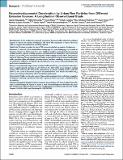Por favor, use este identificador para citar o enlazar a este item:
http://hdl.handle.net/10261/174992COMPARTIR / EXPORTAR:
 SHARE SHARE
 CORE
BASE CORE
BASE
|
|
| Visualizar otros formatos: MARC | Dublin Core | RDF | ORE | MODS | METS | DIDL | DATACITE | |

| Título: | Neurodevelopmental deceleration by urban fine particles from different emission sources: A longitudinal observational study |
Autor: | Basagaña, Xavier; Esnaola, Mikel; Rivas, Ioar; Amato, Fulvio CSIC ORCID ; Álvarez-Pedrerol, Mar; Forns, Joan; López-Vicente, Mónica; Pújol, Jesús A.; Nieuwenhuijsen, Mark J.; Querol, Xavier CSIC ORCID ; Sunyer, Jordi CSIC ORCID | Palabras clave: | Air pollution Particulate matter Pollution exposure Combustion Sulfate Dust |
Fecha de publicación: | 1-oct-2016 | Editor: | National Institute of Environmental Health Sciences (U.S.) | Citación: | Environmental Health Perspectives 124(10):1630-1636 (2016) | Resumen: | Background: A few studies have reported associations between traffic-related air pollution exposure at schools and cognitive development. The role of PM components or sources other than traffic on cognitive development has been little explored. Objectives: We aimed to explore the role of PM sources in school air on cognitive development. Methods: A cohort of 2,618 schoolchildren (average age, 8.5 years) belonging to 39 schools in Barcelona (Spain) was followed up for a year. Children completed computerized tests assessing working memory, superior working memory, and inattentiveness during four visits. Particulate matter ≤ 2.5 μm (PM2.5) was measured during two 1-week campaigns in each school, both outdoors and in the classroom. Source apportionment resulted in nine sources: mineral, organic/textile/chalk, traffic, secondary sulfate and organics, secondary nitrate, road dust, metallurgy, sea spray, and heavy oil combustion. Differences in cognitive growth trajectories were assessed with mixed models with age-by-source interaction terms. Results: An interquartile range increase in indoor traffic-related PM2.5 was associated with reductions in cognitive growth equivalent to 22% (95% CI: 2%, 42%) of the annual change in working memory, 30% (95% CI: 6%, 54%) of the annual change in superior working memory, and 11% (95% CI: 0%, 22%) of the annual change in the inattentiveness scale. None of the other PM2.5 sources was associated with adverse effects on cognitive development. Conclusions: Traffic was the only source of fine particles associated with a reduction in cognitive development. Reducing air pollution from traffic at primary schools may result in beneficial effects on cognition. © 2016, Public Health Services, US Dept of Health and Human Services. All rights reserved. | Versión del editor: | https://doi.org/10.1289/EHP209 | URI: | http://hdl.handle.net/10261/174992 | DOI: | 10.1289/EHP209 | ISSN: | 0091-6765 | E-ISSN: | 1552-9924 |
| Aparece en las colecciones: | (IDAEA) Artículos |
Ficheros en este ítem:
| Fichero | Descripción | Tamaño | Formato | |
|---|---|---|---|---|
| Neurodevelopmental Deceleration by Urban Fine Particles from Different.pdf | 257,39 kB | Adobe PDF |  Visualizar/Abrir |
CORE Recommender
PubMed Central
Citations
36
checked on 20-abr-2024
SCOPUSTM
Citations
85
checked on 23-abr-2024
WEB OF SCIENCETM
Citations
66
checked on 28-feb-2024
Page view(s)
241
checked on 24-abr-2024
Download(s)
157
checked on 24-abr-2024
Google ScholarTM
Check
Altmetric
Altmetric
Artículos relacionados:
NOTA: Los ítems de Digital.CSIC están protegidos por copyright, con todos los derechos reservados, a menos que se indique lo contrario.
